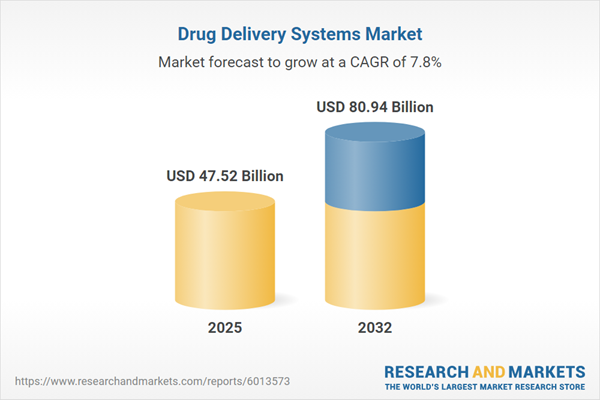Speak directly to the analyst to clarify any post sales queries you may have.
Drug delivery systems are at the forefront of advancing therapeutic outcomes, enabling pharmaceutical stakeholders to address evolving patient needs, stricter regulatory expectations, and competitive operational demands. This sector’s continual transformation is driven by new technologies, strategic collaborations, and innovative routes to meet a changing healthcare landscape.
Market Snapshot: Drug Delivery Systems Market Growth and Outlook
The drug delivery systems market grew from USD 44.22 billion in 2024 to USD 47.52 billion in 2025, and is projected to expand at a CAGR of 7.84%, reaching USD 80.94 billion by 2032. Adoption is supported by widespread innovation in materials science, design of controlled and targeted platforms, and strong demand for integration with digital health solutions.
Scope & Segmentation
This report provides comprehensive coverage of the current landscape and future trajectory of the drug delivery systems market. Market segmentation is detailed across system types, delivery methods, applications, brands, and end users:
- Delivery System Type: Controlled release, delayed release, immediate release, sustained release, targeted delivery
- Delivery Route: Buccal/sublingual, inhalation, injectable (autoinjectors, depot injections, prefilled syringes), nasal, ocular, oral (capsules, suspensions, syrups, tablets), rectal/vaginal, transdermal (gels, patches)
- Therapeutic Application: Autoimmune diseases, cardiovascular diseases, central nervous system disorders, gastrointestinal, hormonal, infectious diseases, oncology, pain management, respiratory diseases
- End User: Ambulatory care centers, home care settings, hospitals & clinics
- Geographical Coverage: North America (United States, Canada, Mexico), Latin America (Brazil, Argentina, Chile, Colombia, Peru), Europe (United Kingdom, Germany, France, Russia, Italy, Spain, Netherlands, Sweden, Poland, Switzerland), Middle East (UAE, Saudi Arabia, Qatar, Turkey, Israel), Africa (South Africa, Nigeria, Egypt, Kenya), Asia-Pacific (China, India, Japan, Australia, South Korea, Indonesia, Thailand, Malaysia, Singapore, Taiwan)
- Companies Profiled: Abbott Laboratories, AptarGroup Inc., AstraZeneca Plc, Boston Scientific Corporation, Cospheric LLC, DelSiTech Ltd., Enable Injections Inc., F. Hoffmann-La Roche AG, Insulet Corporation, Johnson & Johnson Service Inc., Lonza Group Ltd., Merck KGaA, Merit Medical Systems Inc., Novartis AG, Pacira BioSciences Inc., Pfizer Inc., Polysciences Inc., Sanofi S.A., SHL Medical, Societal CDMO by CoreRx Inc., Terumo Corporation, Thermo Fisher Scientific Inc., West Pharmaceutical Services Inc.
Key Takeaways for Senior Decision-Makers
- Emerging technologies—such as nanotechnology, microfluidics, and biodegradable polymers—are revolutionizing precision and sustained drug delivery, improving both therapeutic efficacy and patient experience.
- Increased regulatory activity is creating new requirements for combination products, prompting broader collaboration among formulation scientists, engineers, and compliance specialists.
- The shift toward wearable and digital-integrated drug delivery is strengthening ties between pharmaceutical, medical device, and technology companies, accelerating pipeline innovation and bringing products to market more efficiently.
- Diversification of manufacturing and supplier networks is becoming critical, driven by tariff fluctuations and the need to ensure resilient, localized supply chains capable of meeting shifting global trade dynamics.
- Regional differences in technology adoption, market access, and patient preferences are driving the need for tailored strategies, particularly in fast-growing Asia-Pacific and emerging markets across the Middle East and Africa.
- Increased focus on end-user convenience and safety is supporting growth of self-administration platforms and patient-centric dosing models, particularly in ambulatory and home care settings.
Tariff Impact and Supply Chain Disruption
The introduction of 2025 U.S. tariffs has elevated manufacturing costs and disrupted established supply chains for drug delivery system manufacturers. As a result, many companies are investing in regional production, pursuing dual-sourcing strategies, and renegotiating supplier agreements to protect margins and secure consistent supply. These efforts are also stimulating nearshoring and domestic capacity expansions in select regions, though operational challenges persist around scaling technologies and ensuring regulatory compliance.
Drug Delivery Systems Market Research Methodology
This analysis combines robust secondary research from peer-reviewed literature, patent databases, industry publications, and regulatory filings with primary interviews involving executives, scientists, and supply chain stakeholders across North America, EMEA, and Asia-Pacific. Analytical frameworks—such as SWOT and Porter’s Five Forces—were complemented by triangulation of financial, clinical, and patent data, with extensive validation for credibility.
Why This Report Matters
- Enables data-driven investment decisions by providing granular insight into technology trends, segmentation dynamics, and competitive positioning within the drug delivery systems market.
- Delivers actionable recommendations for operational resilience and innovation-driven growth amid regulatory change and emerging supply chain challenges.
- Supports strategic planning for market entry, R&D prioritization, and cross-industry partnership development based on accurate, thoroughly validated information.
Conclusion
The drug delivery systems market is uniquely positioned for accelerated transformation driven by technology, strategic partnerships, and evolving care models. Organizations adapting to this changing landscape will be better placed to capture growth, meet patient needs, and drive value in a competitive sector.
Additional Product Information:
- Purchase of this report includes 1 year online access with quarterly updates.
- This report can be updated on request. Please contact our Customer Experience team using the Ask a Question widget on our website.
Table of Contents
3. Executive Summary
4. Market Overview
7. Cumulative Impact of Artificial Intelligence 2025
Companies Mentioned
The companies profiled in this Drug Delivery Systems market report include:- Abbott Laboratories
- AptarGroup, Inc.
- AstraZeneca Plc
- Boston Scientific Corporation
- Cospheric LLC
- DelSiTech Ltd.
- Enable Injections, Inc.
- F. Hoffmann-La Roche AG
- Insulet Corporation
- Johnson & Johnson Service, Inc.
- Lonza Group Ltd.
- Merck KGaA
- Merit Medical Systems, Inc.
- Novartis AG
- Pacira BioSciences, Inc.
- Pfizer Inc.
- Polysciences Inc.
- Sanofi S.A.
- SHL Medical
- Societal CDMO by CoreRx, Inc.
- Terumo Corporation
- Thermo Fisher Scientific Inc.
- West Pharmaceutical Services, Inc.
Table Information
| Report Attribute | Details |
|---|---|
| No. of Pages | 189 |
| Published | November 2025 |
| Forecast Period | 2025 - 2032 |
| Estimated Market Value ( USD | $ 47.52 Billion |
| Forecasted Market Value ( USD | $ 80.94 Billion |
| Compound Annual Growth Rate | 7.8% |
| Regions Covered | Global |
| No. of Companies Mentioned | 24 |









